ASM Metals HandBook Vol. 8 - Mechanical Testing and Evaluation
Подождите немного. Документ загружается.


• Electron microscopy, x-ray, and Mössbauer methods (Ref 6, 9, 27, 28, 32, 33, and 34)
• Fracture mechanics methodology (Ref 5, 6, 9, 31, and 35) with sustained loads or overloads
• Subcritical crack kinetics (Ref 9 and 35)
• Interfacial strength (Ref 36)
• Slow-strain-rate tests (Ref 5, 9, 10, 37, 38 and 39)
• Time-dependent tests (Ref 40)
• Internal friction, acoustic emission, and phonon dispersion (Ref 5, 9, 41, and 42)
• Elastic moduli measurements (Ref 43)
• Microautoradiography (Ref 44, 45, and 46)
• Infrared spectroscopy (Ref 47)
Research methods are directed toward improved understanding of the hydrogen embrittlement process and its
fundamental characterization in terms of atomistic models (Ref 18 and 19), cohesive energy (Ref 15 and 48),
discretized dislocation model (Ref 5, 6, 9 and 49), thermodynamically based computations (Ref 50and 51),
hydrogen/metal interaction (Ref 20 and 52), critical-concentration sites (Ref 17, 21, 53, and 54), and strain-
energy models (Ref 8).
The main focus of this section is on accelerated small-specimen test methods for failure analysis and production
control of hydrogen embrittlement. Because hydrogen embrittlement is a time-dependent process, accelerated
testing has economic benefit for testing.
Standardized Tests
The evaluation of hydrogen embrittlement for particular materials and products forms are published in several
standards that include:
Designation
Title
ASTM A 143
Practice for Safeguarding against Embrittlement of Hot-Dip Galvanized Steel Products
and Procedure for Detecting Embrittlement
ASTM B 577
Standard Test for Detection of Cuprous Oxide (Hydrogen Embrittlement Susceptibility)
in Copper
ASTM F 326
Standard Test for Electronic Hydrogen Embrittlement Test for Cadmium-
Electroplating Processes
ASTM F 519
Mechanical Hydrogen Embrittlement Evaluation of Plating Processes and Service
Environments
ASTM F 1459
Determination of the Susceptibility of Metallic Materials to Gaseous Hydrogen
Embrittlement
ASTM F 1624
Standard Test Method for Measurement of Hydrogen Embrittlement Threshold in Steel
by the Incremental Step Loading Technique
ASTM G 142
Determination of Susceptibility of Metals to Embrittlement in Hydrogen-Containing
Environments
ASTM G 129
Slow Strain Rate Testing to Evaluate the Susceptibility of Metallic Materials to
Environments
BS 5899
Method for Hydrogen Embrittlement Test for Copper
BS-EN 2831
Hydrogen Embrittlement of Steels, Test by Slow Bending
BS-EN 2832
Hydrogen Embrittlement of Steels, Notched Specimen Test
BS-EN-ISO
2626
Copper—Hydrogen Embrittlement Test
ISO 2626
Copper—Hydrogen Embrittlement Test
ISO 15330 Fasteners—Preloading Test for the Detection of Hydrogen Embrittlement Parallel
Bearing
The major application area for some of these standard tests are briefly described in this section, followed by
descriptions of test methods and specimen types.
There are also numerous standards related to the prevention of hydrogen embrittlement, such as:

Designation
Title
AMS 2759/9
Hydrogen Embrittlement Relief (Baking) of Steel Parts
ASTM B 839
Residual Embrittlement in Metallic Coated, Externally Threaded Articles, Fasteners, and
Rod
ASTM B 850
Standard Guide for Post-Coating Treatments of Steel for Reducing Risk of Hydrogen
Embrittlement
ASTM B 849
Standard Spec Pre-Treatments of Iron or Steel for Reducing Risk of Hydrogen
Embrittlement
ASTM F
1940
Process Control Verification to Prevent Hydrogen Embrittlement in Plated or Coated
Fasteners
IFI 142 Hydrogen Embrittlement Risk Assessment
From a prevention standpoint, hydrogen embrittlement failures are reduced or eliminated by controlling the
amount of hydrogen introduced during manufacture, processing, and in-service environment (including the use
of cleaners and paint strippers) of materials. Test methods and the necessary prevention controls are covered in
standards such as ASTM F 519 and ASTM F 326, as described below.
Another concern in the evaluation of hydrogen embrittlement appears to involve the identification of residual
stresses that result from manufacturing operations such as heat treatment and, especially, welding. Much more
attention must be given to evaluating the potential for hydrogen embrittlement failures in the presence of
residual stresses. The occurrence and measurement of residual stresses are discussed in more detail in the
article“Residual Stress Measurements” in this Volume.
ASTM F 519 and ASTM F 326. As previously noted, ASTM F 519 and ASTM F 326 describe the testing,
evaluation, and prevention of hydrogen embrittlement. These standards are based on (1) not putting hydrogen
into the steel by keeping the hydrogen in the plating bath at acceptably low levels (ASTM F 326) and (2) using
mechanical tests to ensure that the amount of residual hydrogen after baking is under acceptably low levels
(ASTM F 519).
ASTM F 326. This standard method covers an electronic hydrogen detection instrument procedure for the
measurement of plating permeability to hydrogen, a variable that is related to hydrogen absorbed by steel
during plating and to the hydrogen permeability of the plate during post-plate baking. A specific application of
this method involves controlling cadmium-plating processes in which the plate porosity relative to hydrogen is
critical, such as with cadmium plating of high-strength steel.
This method uses a metal-shelled vacuum probe as an ion gage. A section of the probe shell is cadmium plated
at the lowest current density encountered during the electroplating process. During subsequent baking, the
probe ion current that is proportional to hydrogen pressure is recorded as a function of time. The slope of this
curve has an empirical relationship to failure data, such as those discussed in ASTM F 519.
ASTM F 519. This method covers the evaluation of the hydrogen-generating potential of fluids (aircraft
maintenance chemicals) and the hydrogen embrittlement control of electroplating processes. Test specimens are
installed into the plating bath during the plating of hardware to monitor indirectly the amount of hydrogen in
the plating bath. The acceptable level of hydrogen is determined by a go/no-go situation established by the
failure of a sustained loaded, stressed specimen that has been baked at 190 ± 14 °C (375 ± 25 °F) for a
minimum of 23 h. The procedures and requirements are specified for the following five types of AISI 4340
steel test specimens:
• Type 1a: notched round bars, stressed in tension, under constant load
• Type 1b: notched round bars loaded in tension with stressed O-rings
• Type 1c: notched round bars loaded in bending with loading bars
• Type 1d: notched C-rings loaded in bending with loading bolt
• Type 2a: unnotched ring specimens loaded in bending with displacement bars
For platings, no stress is applied until the parts have been baked; baking is specified to occur within 1 h after
plating. For maintenance chemicals and cleaners, stress is applied before the test specimens are exposed to the
environment. The latter condition is obviously much more severe and discriminates against much lower levels
of hydrogen but is more representative of their end use.
Hydrogen Embrittlement of Copper and Copper Alloys. Hydrogen embrittlement is observed when tough pitch
coppers, which are alloys containing cuprous oxide, are exposed to a reducing atmosphere. Most copper alloys

are deoxidized and thus are not subject to hydrogen embrittlement. Nonetheless, several standards test methods
for copper include:
Designation
Title
ASTM B 577
Standard Test for Detection of Cuprous Oxide (Hydrogen Embrittlement
Susceptibility) in Copper
BS 5899
Method for Hydrogen Embrittlement Test for Copper
BS-EN-ISO
2626
Copper—Hydrogen Embrittlement Test
ISO 2626 Copper—Hydrogen Embrittlement Test
Hydrogen can be involved in copper-zinc or copper-aluminum alloys where hydrogen is more likely to be
produced during cathodic reactions. For copper, minor bulk effects in terms of hydrogen embrittlement may
relate to the limited range of hydrogen solubility in pure copper. This is not the case in the many copper alloys,
such as β brass, that have the ordered B2 crystal structure.
Fasteners and Bolts. ASTM F 1940 is a test method for process control verification to prevent hydrogen
embrittlement in plated or coated fasteners. The test method uses a notched square bar specimen that conforms
to ASTM F 519. ASTM F 1940 is a production-control method for the evaluation and control of the potential
for hydrogen embrittlement that may arise from various sources of hydrogen in a plating or coating process. It
does not address hydrogen embrittlement from environmental exposure (as in the case of ASTM F 1624,
“Standard Test Method for Measurement of Hydrogen Embrittlement Threshold in Steel by the Incremental
Step Loading Technique”). It is also not intended to measure the relative susceptibility of steels to either
process-induced or environmentally induced hydrogen embrittlement.
ASTM F 606, “Standard Method for Conducting Tests to Determine the Mechanical Properties of Externally
and Internally Threaded Fasteners, Washers, and Rivets” also describes a hydrogen embrittlement test for a
metallic-coated externally threaded fastener. This test requires the use of a wedge to produce a sustained
combined tension and bending load. The tension load is specified as 75% of the minimum ultimate tensile
strength. The time specified is 48 h, after which the test fastener is visually and microscopically examined for
hydrogen-embrittlement-induced failure. The torque is then reapplied to attain at least 90% of the initial
tightening torque. The fastener should show no evidence of hydrogen-induced cracking when visually
examined, and the retightening torque should not be less than 90% of the initial tightening torque to indicate
successful testing.
In addition to standard ASTM tests, there are also other examples of nonstandardized tests for special product
forms or evaluation of susceptibility to hydrogen embrittlement. Two examples are described below.
Hydrogen Embrittlement Testing of Steel Screws. Testing for hydrogen embrittlement of steel self-drilling
tapping screws consists of inserting the self-drilling tapping screw against a type B standard plane washer and
tightening to a prescribed torque. This stress is maintained for 24 h; the prescribed torque is then reapplied, and
the screw is removed by the application of a removal torque. The fastener has failed the test if the reapplication
of the torque cannot be obtained, or if the screw cannot be removed without shearing the fastener.
Modified Charpy V-Notch Testing of Bolts. Plated fasteners have been evaluated using a modified Charpy
specimen configuration. Fixture adapters are screwed onto the shank of the fastener and tightened to a total
length of 55 mm (2.16 in.), which is the length of a standard Charpy V-notch specimen. The assembly is
inserted in a four-point bend test fixture meeting ASTM F 519 requirements. The rising-step-load test technique
is used, and the specimen is loaded directly to failure. Overload fracture is measured and observed with
scanning electron microscopy (SEM), and the maximum fracture load is thus established.
A second sample is then step loaded at 1 h intervals at each step until crack initiation begins, usually within 8 h.
Crack extension continues, and the decreasing load is recorded. Scanning electron microscopy can be used to
verify the presence of brittle cracking typical of hydrogen-embrittlement-type failures (i.e., flat facets instead of
dimpled rupture).
Test Configurations
Conventional test methods include the cantilever beam, wedge-opening load, contoured double-cantilever beam
tests, three-point and four-point bending, disk-pressure tests, and slow-strain-rate tension tests. Disk-pressure
tests are used for testing in hydrogen atmosphere. The cantilever beam, wedge-opening load, and contoured
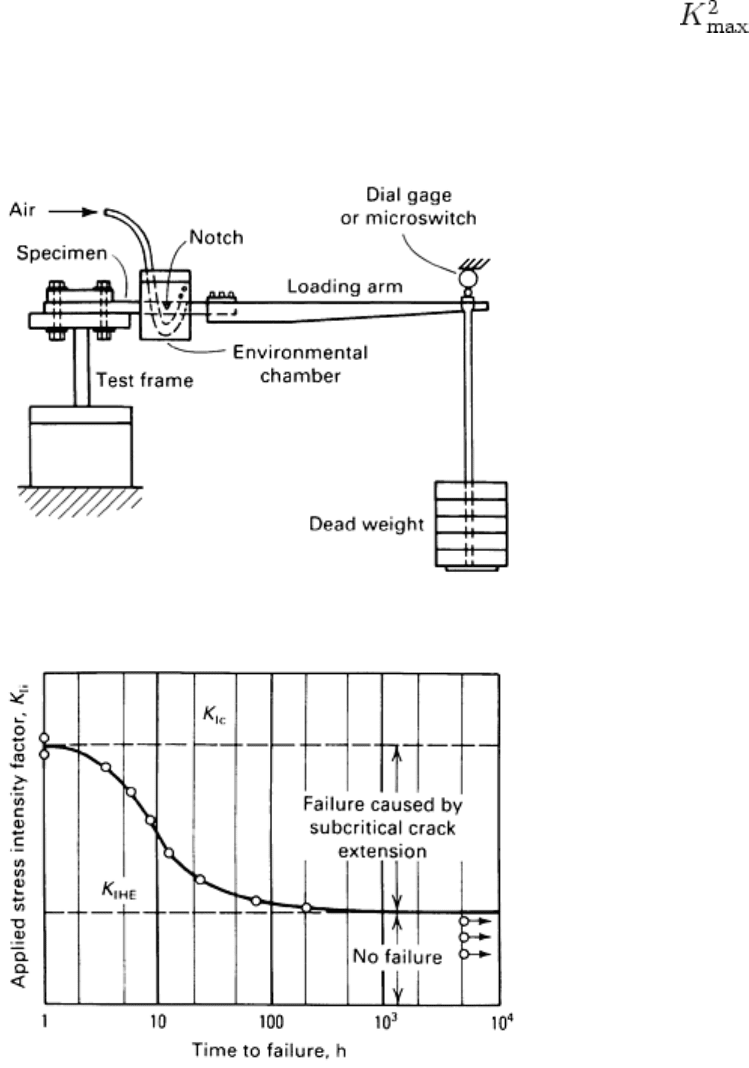
double-cantilever beam tests have also been adapted for testing in high-pressure gaseous hydrogen
environments.
The cantilever beam test is a constant-load test in which a V-notched specimen is inserted along a portion of the
beam and enclosed by an environmental chamber (Fig. 3). A crack at the root of the V-notch is initiated and
extended by fatigue before testing. The notch-root thickness is prescribed by the requirement of < 0.4
B/YS
2
(where B is the thickness and YS is the yield strength of the specimen), although this is often excessive
for high-toughness steels. The specimen is subjected to a constant load over a predetermined time period. As
the crack grows, the stress intensity increases. Time to failure is plotted versus applied stress intensity. The
lower limit of the resultant curve is a threshold stress intensity for hydrogen embrittlement, K
IHE
, as shown in
Fig. 4.
Fig. 3 Fatigue-cracked cantilever beam test specimen and fixtures. Source: Ref 55
Fig. 4 Procedure to obtain K
IHE
with precracked cantilever beam test specimen. Source: Ref 55
The K
IHE
results of a cantilever beam test depend on how much time elapses before the test is terminated.
Recommended test periods for establishing the true stress-intensity threshold range from 200 h, which is typical
for hydrogen embrittlement testing, to as long as 5000 h (Ref 56). Another limitation of this test method is that
it can be expensive in terms of materials and machining. As many as 12 specimens, placed under different loads
in separate test machines, are needed for each test in order to obtain valid K
IHE
values.
The wedge-opening load test applies a constant wedge- or crack-opening displacement; as the crack extends,
stress intensity decreases until crack arrest occurs (Fig. 5). The initial load is assumed to be slightly above K
IHE
.
The specimen is maintained under these conditions for about 5000 h to establish the threshold. The crack grows
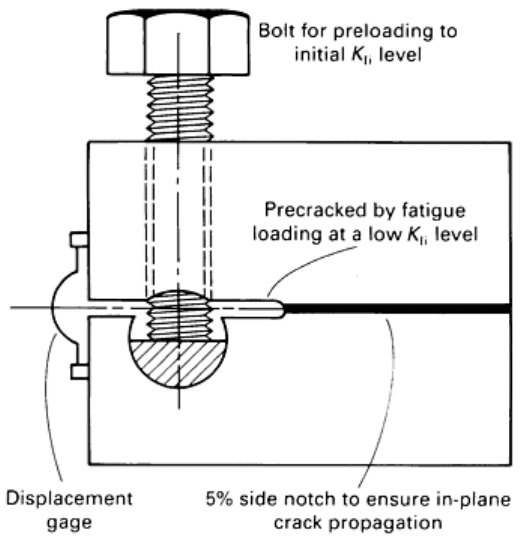
to a point after which further growth is not measured (K
IHE
). However, it is difficult to determine precisely
when the no-growth criterion is met. Crack-tip opening displacement should also be monitored.
Fig. 5 Schematic showing basic principle of modified wedge-opening load test specimen
The wedge-opening load test and the cantilever beam test both require costly and time-consuming steps and
result in a parameter, K
IHE
, whose design significance is questionable. However, the parameter does provide a
relative ranking of susceptibility to hydrogen embrittlement or, more generally, SCC. The advantage of the
wedge-opening load test is that only one specimen is required to measure K
IHE
.
Generally, the threshold stress intensity measured with the wedge-opening load test is lower than that measured
with the cantilever beam test. For example, Fig. 6 shows the results of wedge-opening load and cantilever beam
tests on 25.4 mm (1 in.) thick iron-nickel-cobalt alloy steel specimens. The data imply that the crack arrest K
IHE
values from the wedge-opening load test is the lower than the limit for the cantilever beam K
IHE
threshold.
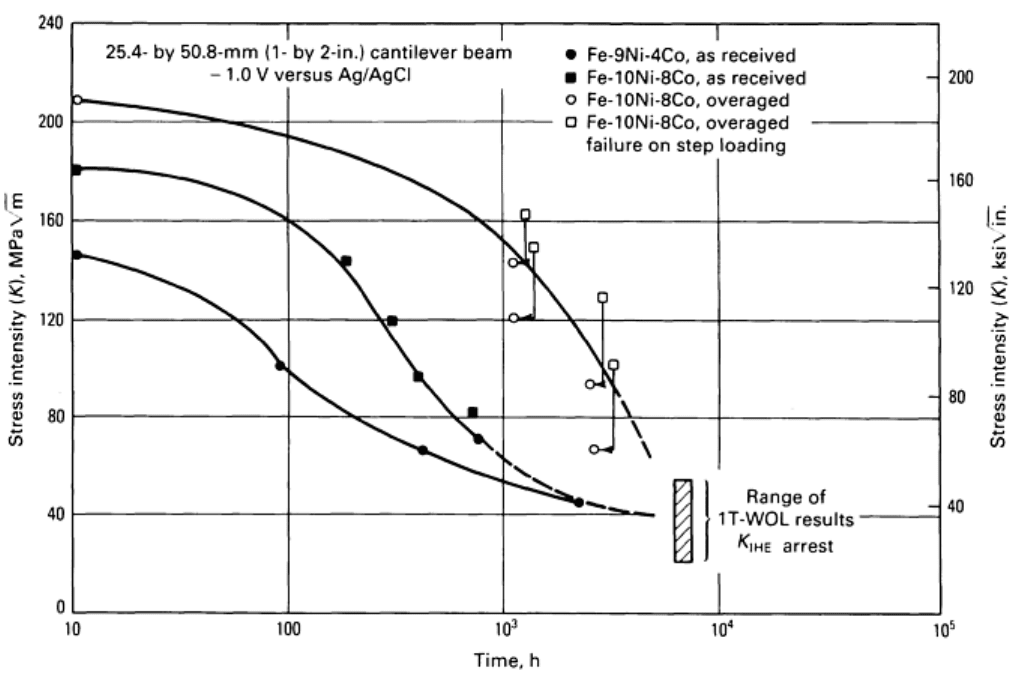
Fig. 6 Comparison of single-edge-notched cantilever beam and wedge-opening load (WOL) test results
for hydrogen embrittlement cracking of iron-nickel-cobalt steels. The open circles represent “no
fracture” at various exposure times for an overaged Fe-10Ni-8Co alloy in a cantilever beam test. The
open squares indicate failure at increased stress intensities, following step loading at various exposure
times at the lower stress intensity. Source: Ref 57
Corrosion reactions, accompanied by expansion in volume, may occur at the crack tip. This changes the
opening displacement and increases the load, thus altering the desired testing conditions. In long-term tests, it is
essential to ensure that the concentration and the composition of the environmental solution do not change over
time. For example, evaporation may cause the solution level to drop the crack line of the specimen; this would
render the test invalid. The data plots in Fig. 6 also suggest that load increases during the test produce more
aggressive hydrogen embrittlement conditions. This may be due to the possible formation of an oxide film on
the surface. When the load is increased, the oxide film is broken, exposing fresh metal, and more hydrogen is
produced at the crack tip. For this reason, the test should use a rising load, because the constant-load cantilever-
beam test does not provide worst-case (fresh metal exposed) loading conditions.
The data also suggest that the cantilever beam test can generate an artificially high K
IHE
threshold, depending on
the time limit selected. If the test had been terminated at 200 h rather than at 5000 h, the reported K
IHE
values
from the cantilever beam test (Fig. 6) would have been four times higher than those measured after the longer
time period. Similarly, if insufficient time is allowed in the wedge-opening load test, the incubation period may
not be exceeded, and no crack growth will result.
The contoured double-cantilever beam test is used to measure crack growth rate at a constant stress-intensity
factor. This test simplifies the calculation of stress intensity by using a contoured specimen so that stress
intensity is proportional to the applied load and is independent of the crack length. Under a constant load, stress
intensity also remains constant with crack extension. For the test geometry shown in Fig. 7, the stress-intensity
factor equals 20 times the load (K = 20P).
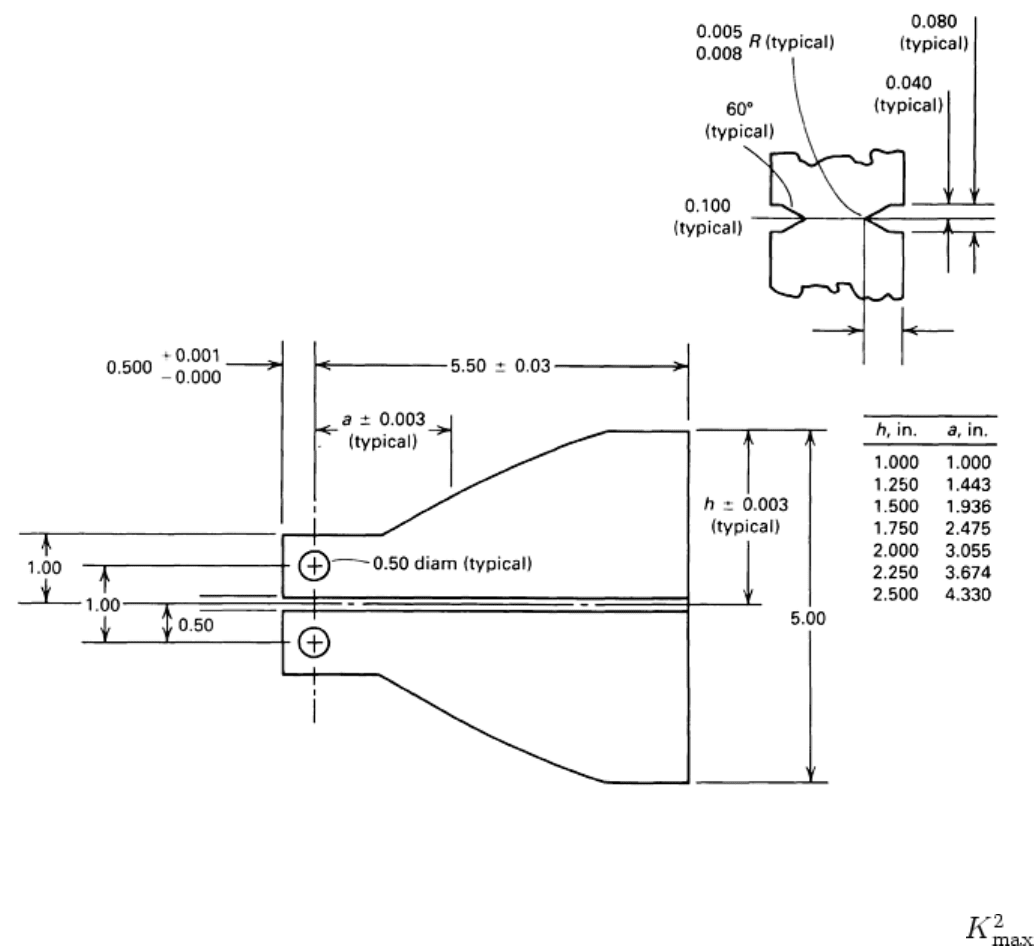
Fig. 7 Dimensions and configuration for double-cantilever beam test specimen. Specimen contoured to
3a
2
/h
3
+ 1/h = C, where C is a constant. All values given in inches
Data on hydrogen embrittlement can be obtained with specimens below the thickness requirement of <
0.4 B/YS
2
by using side grooves (Ref 58). Side grooves provide additional constraint on the material being
tested. They also enable the maintenance of a plane-strain condition in a thin specimen by enhancing stress
triaxiality. This method has been extensively used to study the effect of heat treatment (hardness) and
environment on the hydrogen stress cracking of AISI 4340 steels (Fig. 8). The contoured double-cantilever
beam test has also been used to study the stress history effect that produces an incubation time before hydrogen
stress cracking (Ref 59).
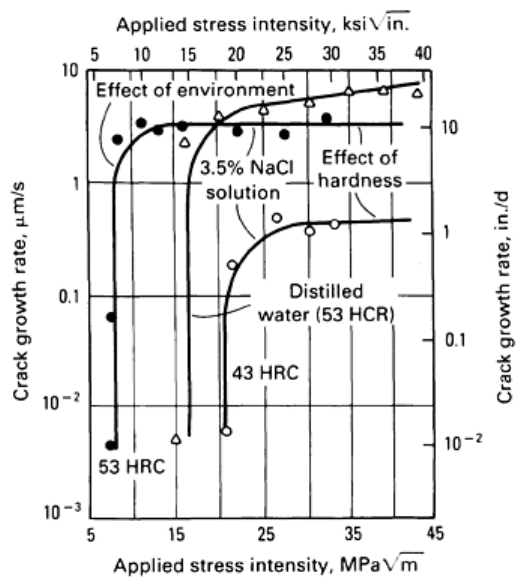
Fig. 8 Hydrogen embrittlement crack growth rate as a function of applied stress intensity for two
different hardnesses and environments for an AISI 4340 steel contoured double-cantilever beam test
specimen
A new method for accelerating the collection of near-threshold corrosion fatigue crack propagation data, using
local hydrogen embrittlement in the crack-tip region, has been investigated for ASTM A 710 HSLA steel with
the “constant-K” contoured double-cantilever beam (CDCB) specimens (Ref 60). Near-threshold fatigue crack
growth rates were found to be 100 times faster in the locally hydrogen-charged specimens than in the
uncharged material. Fatigue thresholds, ΔK
th
, were also defined in less than one-fifth the time required for load
shedding tests in air at 0.2 Hz. Although demonstrated for HSLA steels, the technique is applicable to any
material that can be embrittled by hydrogen.
Three-Point and Four-Point Bend Tests. The contoured double-cantilever beam test uses a constant load to
maintain a constant stress-intensity factor with crack extension. The same effect can be produced by using a
three- or four-point bend test under displacement control. These tests use heavily side-grooved Charpy V-notch
specimens (Fig. 9). Because crack-opening displacement is constant as the crack extends, the load decreases;
therefore, there is a slight initial increase in stress intensity to a maximum value that drops slightly as the ratio
of crack depth to specimen width exceeds 0.5. Typically, stress intensity is constant within a small range.
Figure 10 compares the change in stress-intensity factor with crack extension as a function of load control to
that of displacement control for a three-point bend specimen.
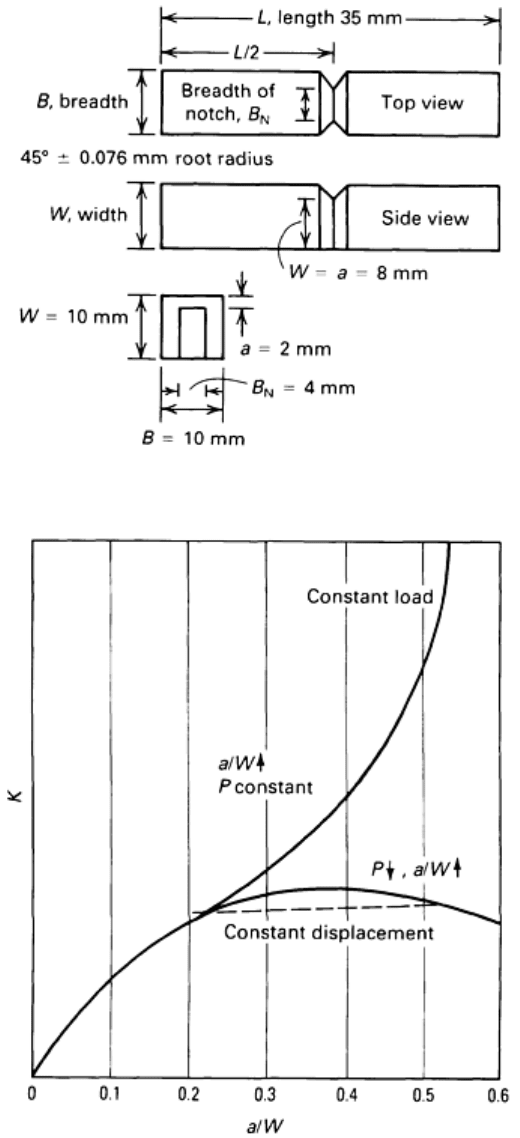
Fig. 9 Side-grooved Charpy V-notch test specimen used for three- and four-point bend tests
Fig. 10 Change in stress-intensity factor with crack extension as a function of load control and
displacement control for a three-point bend specimen
The constraint effect and thickening action of the side-groove on a Charpy-size specimen in three-point bending
are discussed in Ref 61. Evaluation of hydrogen embrittlement under three-point or four-point bending is also
tested with other types of besides side-grooved Charpy specimens. For example, fracture tests using blunt-
notched specimens tested in four-point bending have been used in the investigation of hydrogen damage
mechanisms in a commercially produced 9Cr1Mo (Ref 62) and AISI 1080 steel (Ref 63). A nonstandard
double-beam (DB) specimen in four-point bending was also used in the evaluation of cracking in wet H
2
S
environments for two commonly used pressure vessel steels (ASTM A 516-70 and A 285C) (Ref 64). The four-
point test on these two pressure vessel steels was done in conjunction with several other test methods including:
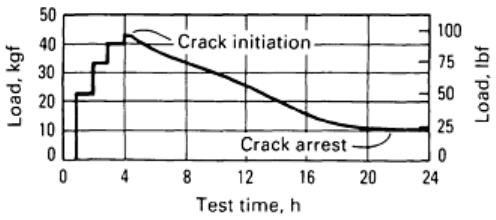
• NACE TM0177-90A tensile tests
• NACE TM0177-90A tensile test with one-side (OS) exposure
• NACE TMO284
• NACE TM0284 with TM0177 solution
• TM0184 with OS exposure
• Nonstandard DB specimen in four-point bending with both immersion (IMM) and OS exposure
All the test methods showed a higher susceptibility to hydrogen-induced cracking in the A516-70 steel than in
the A285C steel (Ref 64).
The rising-step-load test provides a stress intensity that is different at each load but that remains constant with
crack extension as each load level is sustained. Crack initiation is signaled by a drop in load (Fig. 11). The
rising step-load test was developed as an accelerated low-cost test for measuring the resistance of steels
(particularly weldments) to hydrogen embrittlement (Ref 57, 66). The threshold obtained by this method could
be slightly higher if the test duration of each load is too short, but the test duration can be extended near the
initiation loads in duplicate tests in order to obtain a more accurate measurement.
Fig. 11 Typical load-time record for four-point rising step-load test. Source: Ref 65
To index susceptibility to hydrogen-assisted cracking, the test should last no longer than 24 h, and the hydrogen
source should reflect the most aggressive environment (Ref 3). In one experiment, a 3.5% sodium chloride
solution was selected to simulate seawater, and a cathodic potential of -1.2 V versus saturated calomel electrode
(SCE) was used to generate hydrogen in order to reproduce the extreme conditions of sacrificial anodic
protection generally found on a ship hull.
A Charpy specimen is used because such specimens are small and easy to machine and handle. Instead of using
fatigue precrack, a machined notch-root is sometimes done to lower the cost and to give less ambiguous
environmental conditions at the crack tip. A common practice used in crack growth rate tests to prevent the
crack from branching is to use specimens with deep side grooves. Side grooves are also used in crack-opening
displacement or J-integral testing in order to cause load displacement curves to increase monotonically to
fracture by inducing a highly triaxial stress field at the crack tip. Because a Charpy specimen is small, deep side
grooves produce a triaxial stress field at the notch and thus promote crack initiation. The extent of the side
grooving is such that the remaining ligament is only 40% of the original thickness. The modified Charpy
specimen dimensions are shown in Fig. 9.
Specimen loading under four-point bending can be accomplished by means of beams and an instrumented bolt
as shown in Fig. 12. Bending is done under constant displacement control and stress intensity to produce crack
growth. The specimen is enclosed in an environmental chamber with a potentiostat to produce hydrogen while
under stress.
